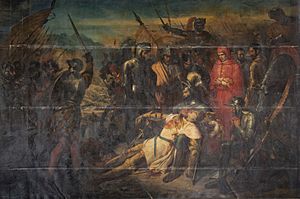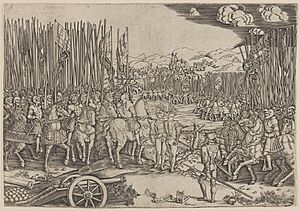Battle of Ravenna (1512) facts for kids
Quick facts for kids Battle of Ravenna |
|||||||
|---|---|---|---|---|---|---|---|
| Part of the War of the League of Cambrai | |||||||
 Mort de Gaston de Foix à Ravenne, 11 avril 1512, oil on canvas by Ary Scheffer, 1824, Palace of Versailles |
|||||||
|
|||||||
| Belligerents | |||||||
| Commanders and leaders | |||||||
| Strength | |||||||
|
|
||||||
| Casualties and losses | |||||||
|
|
||||||
The Battle of Ravenna was a huge fight that happened on April 11, 1512. It was a major part of the War of the League of Cambrai. This battle was between the Holy League (a group of countries including Spain and the Papal States) and the armies of France and their friends from Ferrara.
Even though France and Ferrara won, their victory was sad. Their young and brilliant general, Gaston of Foix, died in the battle. Because of his death, the French couldn't keep control of northern Italy. They had to leave Italy completely later that summer.
Contents
What was the Battle of Ravenna?
The Battle of Ravenna was a very important battle during the Italian Wars. These wars were a series of conflicts in Italy from 1494 to 1559. Many European powers fought for control of the rich Italian lands. The Battle of Ravenna showed how new weapons like cannons were changing warfare.
Why was the Battle of Ravenna fought?
In early 1512, French forces in Italy were led by Gaston de Foix. He was trying to take control of cities in the Romagna and Veneto regions. These areas were important to the Holy League. Gaston knew that England was planning to attack France soon. This would make many of his soldiers leave Italy. So, he wanted to fight the Holy League's main army quickly.
In late March, Gaston and his ally, Alfonso I d'Este, Duke of Ferrara, marched towards Ravenna. They started attacking the city on April 9. The Papal troops defending Ravenna fought hard and stopped the French attacks.
Pope Julius II was worried about losing Ravenna. He ordered his army, led by Ramón de Cardona, to go help the city. By April 10, the Spanish and Papal armies were very close to the French. Gaston de Foix decided to attack them right away. On Easter morning, April 11, the French army moved to face the Spanish and Papal forces.
How were the armies set up?
Both armies had their soldiers arranged in specific ways. The French army formed a curved line. Close to the river were their heavy cavalry, led by Jacques de La Palice. Next to them were most of the foot soldiers, including Gascon crossbowmen and German landsknechts. The French also had many cannons. Alfonso I d'Este brought 50 new cannons that fired metal cannonballs. These cannons could shoot faster than older ones.
The Holy League army also had its own setup. Their heavy cavalry was led by Fabrizio Colonna. Their foot soldiers were mostly Spanish and Papal troops, commanded by Pedro Navarro. The Holy League also had light cavalry and about 30 cannons. They also used special "war wagons" with scythe blades and guns.
What happened during the battle?
The big cannon fight
The battle started with a huge cannon duel. The French and Holy League armies fired at each other for more than two hours. This was one of the biggest artillery fights seen at that time. The French cannons caused a lot of damage to the Holy League's camp. Many soldiers had to hide in trenches or lie down to avoid the cannonballs.
The Duke of Ferrara moved some of his cannons to the side of the battlefield. From there, his guns fired into the Holy League's cavalry, causing many injuries. Another French general, Yves d'Alégre, also moved cannons to the other side of the enemy camp. These cannons fired directly into the Holy League's cavalry, causing even more damage.
Cavalry charges and clashes
Because of the heavy cannon fire, the Holy League's cavalry had to move. They charged towards the French lines. The French cavalry, led by Gaston de Foix, met them head-on. There was a long and fierce fight between the French and Spanish horsemen.
Meanwhile, Fabrizio Colonna, another Holy League commander, charged the French line near the river. But French reinforcements arrived, and Colonna's cavalry began to break apart. Many of his soldiers ran away or retreated. The French cavalry then chased the fleeing Spanish soldiers.
Infantry battles
While the cavalry fought, Gaston de Foix ordered his foot soldiers to attack the Holy League's camp. French crossbowmen and pikemen moved towards the enemy trenches. They faced strong resistance from the Spanish infantry.
The German landsknechts, fighting for France, tried to break into the fortified camp. They suffered many losses as they fought hand-to-hand with the Spanish swordsmen. The fighting was very intense, with many soldiers on both sides being killed or wounded.
The final moments
As the battle continued, the French cavalry returned from chasing the Spanish. They joined the fight, attacking the Spanish foot soldiers from all sides. The Spanish formations were overwhelmed. Many were killed, and their commanders, Colonna and Navarro, were wounded and captured.
A few thousand Spanish soldiers managed to escape. But as they were leaving the battlefield, they met Gaston de Foix and his small group of knights. In the fight that followed, Gaston de Foix was killed. This was a huge loss for the French army.
What happened after the battle?

The Battle of Ravenna lasted for eight hours. More than 10,000 soldiers died on both sides. The death of Gaston de Foix was a terrible blow to the French. He was a young, talented general who had won many battles. His soldiers admired him greatly. Many historians believe the Italian Wars might have been very different if he had lived.
After Gaston's death, Jacques de La Palice took command of the French army. He decided to finish the siege of Ravenna instead of chasing the remaining Spanish forces. The city soon fell, and the French looted it for three days. However, many French soldiers were called back to France after the battle. This forced La Palice to leave Italy later that year.
Even though the Spanish army was almost destroyed at Ravenna, Ramón de Cardona managed to raise another army in 1513. Both Navarro and Colonna, who were captured, would later fight in other battles.
Images for kids
-
The Death of Gaston de Foix in the Battle of Ravenna on 11 April 1512 (oil on canvas by Ary Scheffer, c. 1824)
See also
 In Spanish: Batalla de Rávena (1512) para niños
In Spanish: Batalla de Rávena (1512) para niños



